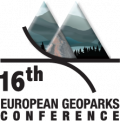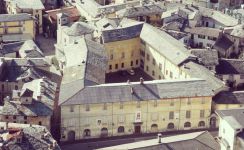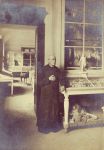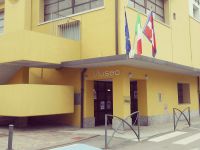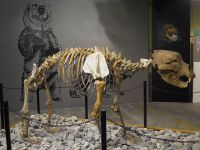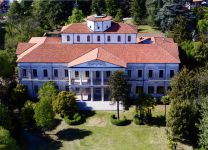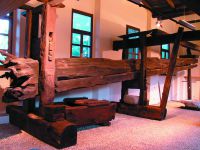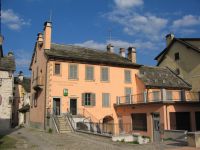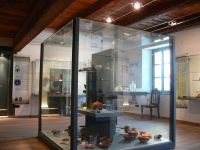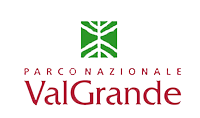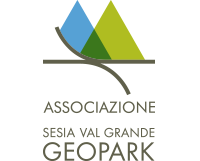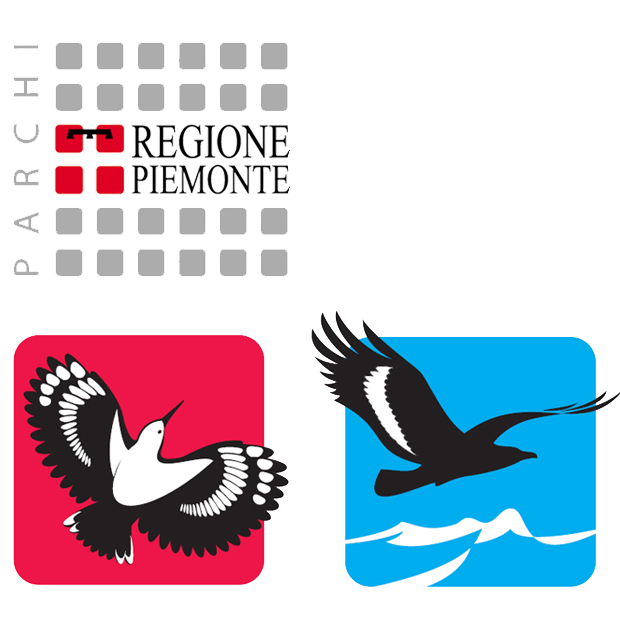- Home
- Places of interest
- Museums
Museums
VARALLO ART GALLERY
Founded at the end of the nineteenth century, in Varallo, by two societies (The Society for the Encouragement of the Study of Graphic Arts, and The Society for the Conservation of Artworks and Monuments in Valsesia), it is based in the Museum Palace of Varallo. The Art Gallery preserves examples of Piedmont and Sesia valley painting from the 15th to the 20th centuries, with particular attention to the artists who carried out their work in close connection and in continuous dialogue with the artistic experiences that developed at the Sacred Mount. The current exhibition includes a large group of sculptures from the Sacred Mount and from the churches of the valley, plus paintings by Gaudenzio Ferrari and his students, including Bernardino Lanino.
Information:
Palace of the Museums - https://www.pinacotecadivarallo.it/
Via Pio Franzani 2 - 13019 Varallo (VC) Telephone: 0163.51424 Fax: 0163.564354
Email: This email address is being protected from spambots. You need JavaScript enabled to view it.
PIETRO CALDERINI MUSEUM OF NATURAL HISTORY – VARALLO
Located on the second floor of the Palace of Museums in Varallo, the Pietro Calderini Museum of Natural History was opened in 1867 and in a relatively short time the collections grew and were enriched by donations coming not only from Valsesia but also from outside, so much so that all branches of science and natural history were represented.
Collections about human activities were soon added to those about natural history: these included archaeological, ethnographic, numismatic, arms and autograph sections.
The museum was previously located on the first floor but since the 1960s it has been on the second floor of the Palazzo dei Musei. The natural history section was updated in June 2017, which while it valued the original nineteenth-century structure also included a specially-made route for new generations of visitors.
The archaeological and ethnographic sections will also be integrated into the new museum tour in the years to come.
Information:
Palazzo dei Musei - https://www.pinacotecadivarallo.it/
Via Pio Franzani 2 - 13019 Varallo (VC)
Telefono: 0163.51424 Fax: 0163.564354
Email: This email address is being protected from spambots. You need JavaScript enabled to view it.
CARLO CONTI ARCHAEOLOGICAL AND PALEONTOLOGICAL MUSEUM - BORGOSESIA
The Museum is dedicated to the sculptor and Honorary Inspector of the Antiquity Authority, Carlo Conti, who in 1931, with his work "Valsesia Archeologica", already prefigured an actual archaeological museum of the valley. Despite the archaeological excavations and studies at Mount Fenera, where the important Ciutarun and Ciota Ciara caves are located, the museum was only opened in 2007, restarting dissemination of this knowledge and a resumption of research activities at Mount Fenera and in the valley, in close relationship with both the Authority for the Cultural Heritage of Piedmont and universities, in particular those of Ferrara and Geneva.
The exhibition allows visitors to learn about the abundant collection of fossils of the Pleistocene fauna from the caves of Fenera, and the exceptional bones and material traces of the Neanderthals’ presence that are unique in Piedmont. For this reason the Museum of Borgosesia is an important place for information about the Paleolithic in Piedmont. The first Iron Age population concentration began in what is now Borgosesia, with the inhabited areas in the Hospital zone and the first tombs in the western part of the city, controlling the access to the important mineral resources of the upper valley. In the second Iron Age some female grave goods show the first Insubric and then Valaisan characterization of the population of the ancient "Seso" up to the progressive administrative assimilation into the Roman world. The tombs of Via N. Sottile, the remains of the settlement and the engravings are good examples of the community of Seso in Roman times, located along a primary route that connected Ivrea to Domodossola and to Locarno. The museum itinerary includes the findings of the probable sacred areas of the pre-Roman and Roman center of Borgosesia, and the medieval evidence from the surrounding areas.
To complete the exhibition, in 2012, a permanent exhibition of geological interest was added, linked to the existence of a "supervolcano", recognized in 2009 by the scientific world after the publications of its discoverers, Sinigoi and Quick, geologists of the Universities of Trieste and Dallas, who had been studying Valsesia for over thirty years.
Information:
Via Combattenti, 13011 Borgosesia (VC) - Tel. 0163 22205
Email: This email address is being protected from spambots. You need JavaScript enabled to view it.
Hours:
Tuesday and Thursday 10.00-12.30 and 14.00-17.30
Saturday 15.00-18.00
Free entry
HISTORICAL ETHNOGRAPHIC MUSEUM OF LOW VALSESIA
This museum is located in the eastern wing of the neoclassical Villa Caccia in Romagnano Sesia. This prominent structure of the architect Antonelli, once the center of the wine-producing activity and of the "Premiata Fattoria Vinicola dei conti Caccia", now contains a journey through the history, traditions and material culture of Romagnano Sesia and the surrounding territory.
Information:
Romagnano Sesia (NO), Viale Antonelli 3 Tel: 0163 827237 - 347 5391441 - 393 2776391 Email: This email address is being protected from spambots. You need JavaScript enabled to view it.
www.museostoricoromagnano.it
MUSEUM OF THE LANDSCAPE OF VERBANIA
The Landscape Museum of Verbania holds the most important collections of pictorial and sculptural art of the territory. It was founded by Antonio Massara, in 1909, with the aim of enhancing the beauty of the Verbano landscape through art: in fact the name, at its foundation, was “The Artistic Historical Museum of the Verbano and the adjacent Valleys”. Currently the Museum is a complex divided into three locations: Palazzo Viani Dugnani and Palazzo Biumi Innocenti, in Pallanza, together with Casa Ceretti in Intra. Fifteen halls of Palazzo Viani Dugnani, a Baroque palace dating back to the years between 1600 and 1700, are devoted to the painting section; here, in a very rich artistic itinerary, works by the most important local artists are collected, including Daniele Ranzoni, Achille Tominetti, Carlo Fornara and Mario Tozzi. The section dedicated to sculpture hosts works by internationally known artists, such as Arturo Martini and Paolo Troubetzkoy.
The archaeological section includes grave goods from Ornavasso, which forms the most important nucleus of the section, as well as material that testifies to Celtic and Roman influences, a collection of objects of Magna Graecia and other objects of Roman and Etruscan origin.
At Palazzo Biumi-Innocenti, one of the oldest buildings in the city of Verbania, there is a section dedicated to popular religiosity: here are collected ex-voto offerings made between the sixteenth and twentieth century and holy pictures from all regions of Italy and the world. Since 1995 the museum offers educational activities thanks to volunteer teachers and artists; the activities are both for adults and also for children, with worksheets and hands-on sessions.The main exhibition of the Museum is in Palazzo Viani Dugnani, in Verbania Pallanza, which hosts the Troubetzkoy plaster cast collection, the sculpture collection, the picture gallery and temporary exhibitions.
Information:
Address: Via Ruga, 44 - Verbania Pallanza - tel. 0323 502254
Hours:
Tuesday to Friday: from 10.00 to 18.00
Saturday and Sunday and public holidays: from 10.00 to 19.00
www.museodelpaesaggio.it
The Casa Elide Ceretti exhibition center in Verbania Intra is the new cultural center for the Museum and for the City of Verbania; it which hosts various activities and open on special occasions
The Archeology collection is hosted in the detached branch of Ornavasso; part is exhibited at the Town Hall building in Via Sergio Jonghi n. 3 and can be visited by appointment (tel: 0323 838300)
ARCHAEOLOGICAL MUSEUM OF SOAPSTONE
The Archaeological Museum of Soapstone, of Val Grande National Park, is located in the Praetorian Palace in Malesco, and is part of the Ecomuseum of soapstone and stoneworkers. Inside the museum the history of the use of soapstone is developed in an exhibition that combines various aspects: archaeological, ethnographical and geological. The museum is rich in finds that, since prehistoric times, document the progressive ability of humans to use natural resources. The exploitation of soapstone was fundamental and became the fulcrum of the flourishing economy of the territory; the stone artifacts and a considerable number of valuable and imported objects underline the active role of the Valley in the ancient commercial circuits. The exhibited objects testify how this material was worked to obtain different artifacts, being used in the most varied way, from small everyday objects to architectural elements. From autumn 2013there has also been a geological section where the stages of “the stones that became history” are shown: soapstone, marble and carbonate rocks are dealt with in their total environmental relationship, from geological history to use.
Information: http://www.parcovalgrande.it/pagina.php?id=53
"M. BERTOLANI" GEOLOGICAL MUSEUM
The village of Sambughetto, in the Strona valley, hosts the Naturalistic Museum, a point of interest of the Ecomuseum of Lake Orta and Mottarone, which includes a geological section named in honour of Professor Mario Bertolani, of the University of Modena, who has studied the rich geological heritage of the Strona valley. The aim of the museum is to show the public the geological variety of the area, enriched with numerous fossil remains and the presence of karstic cavities, a rather unusual phenomenon in north-eastern Piedmont. A visit to the museum provides information on the minerals and rocks of the valley, on the quarries and on the mines, complete with information related to the caves and the legends that their presence has nourished.
Information: pietredelcusio.weebly.com/museo-geologico-m-bertolani.html
Copyright © 2014 Sesia Val Grande Geopark - Email This email address is being protected from spambots. You need JavaScript enabled to view it.



